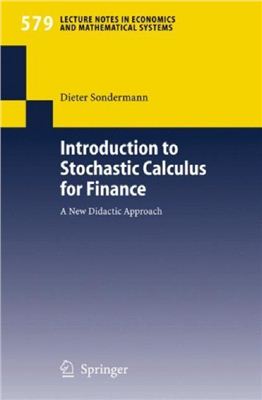The notes are based on courses offered regularly to graduate
students
in economics and mathematics at the University of Bonn choosing financial
economics as special topic. To students interested in finance
the course opens a quick (but by no means dirty) road to the tools
required for advanced finance. One can start the course with what they
know about real analysis (e.g. Taylor’s Theorem) and basic probability
theory as usually taught in undergraduate courses in economic departments
and business schools. What is needed beyond (collected in Chap.
1) can be explained, if necessary, in a few introductory hours.
Contents.
Introduction.
Preliminaries.
Brief Sketch of Lebesgue’s Integral.
Convergence Concepts for Random Variables.
The Lebesgue-Stieltjes Integral.
Exercises.
Introduction to It?o-Calculus.
Stochastic Calculus vs Classical Calculus.
Quadratic Variation and -dimensional It?o-Formula.
Covariation and Multidimensional It?o-Formula.
Examples.
First Application to Financial Markets.
Stopping Times and Local Martingales.
Local Martingales and Semimartingales.
It?o’s Representation Theorem.
Application to Option Pricing.
The Girsanov Transformation.
Heuristic Introduction.
The General Girsanov Transformation.
Application to Brownian Motion.
Application to Financial Economics.
The Market Price of Risk and Risk-neutral Valuation.
The Fundamental Pricing Rule.
Connection with the PDE-Approach.
(Feynman-Kac Formula).
Change of Numeraire.
Solution of the Siegel-Paradox.
Admissible Strategies and Arbitrage-free Pricing.
The Forward Measure.
Option Pricing Under Stochastic Interest Rates.
Term Structure Models.
Different Descriptions of the Term Structure of Interest.
Rates.
Stochastics of the Term Structure.
The HJM-Model.
Examples.
The LIBOR Market Model.
Caps, Floors and Swaps.
Why Do We Need It?o-Calculus in Finance?
The Buy-Sell-Paradox.
Local Times and Generalized It?o Formula.
Solution of the Buy-Sell-Paradox.
Arrow-Debreu Prices in Finance.
The Time Value of an Option as Expected Local Time.
Appendix: It?o Calculus Without Probabilities.
References.
in economics and mathematics at the University of Bonn choosing financial
economics as special topic. To students interested in finance
the course opens a quick (but by no means dirty) road to the tools
required for advanced finance. One can start the course with what they
know about real analysis (e.g. Taylor’s Theorem) and basic probability
theory as usually taught in undergraduate courses in economic departments
and business schools. What is needed beyond (collected in Chap.
1) can be explained, if necessary, in a few introductory hours.
Contents.
Introduction.
Preliminaries.
Brief Sketch of Lebesgue’s Integral.
Convergence Concepts for Random Variables.
The Lebesgue-Stieltjes Integral.
Exercises.
Introduction to It?o-Calculus.
Stochastic Calculus vs Classical Calculus.
Quadratic Variation and -dimensional It?o-Formula.
Covariation and Multidimensional It?o-Formula.
Examples.
First Application to Financial Markets.
Stopping Times and Local Martingales.
Local Martingales and Semimartingales.
It?o’s Representation Theorem.
Application to Option Pricing.
The Girsanov Transformation.
Heuristic Introduction.
The General Girsanov Transformation.
Application to Brownian Motion.
Application to Financial Economics.
The Market Price of Risk and Risk-neutral Valuation.
The Fundamental Pricing Rule.
Connection with the PDE-Approach.
(Feynman-Kac Formula).
Change of Numeraire.
Solution of the Siegel-Paradox.
Admissible Strategies and Arbitrage-free Pricing.
The Forward Measure.
Option Pricing Under Stochastic Interest Rates.
Term Structure Models.
Different Descriptions of the Term Structure of Interest.
Rates.
Stochastics of the Term Structure.
The HJM-Model.
Examples.
The LIBOR Market Model.
Caps, Floors and Swaps.
Why Do We Need It?o-Calculus in Finance?
The Buy-Sell-Paradox.
Local Times and Generalized It?o Formula.
Solution of the Buy-Sell-Paradox.
Arrow-Debreu Prices in Finance.
The Time Value of an Option as Expected Local Time.
Appendix: It?o Calculus Without Probabilities.
References.

